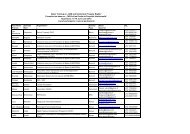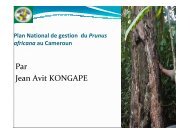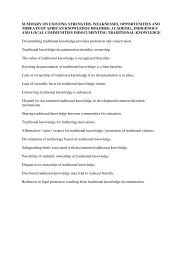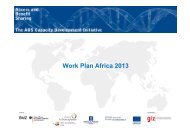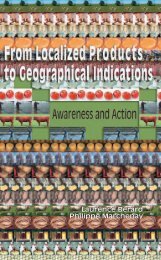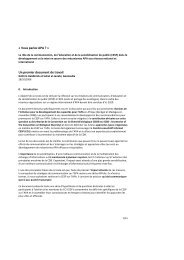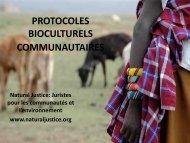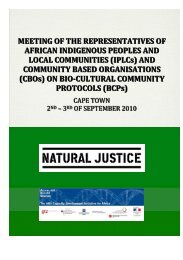The History of Farmers' Rights - Fridtjof Nansens Institutt
The History of Farmers' Rights - Fridtjof Nansens Institutt
The History of Farmers' Rights - Fridtjof Nansens Institutt
You also want an ePaper? Increase the reach of your titles
YUMPU automatically turns print PDFs into web optimized ePapers that Google loves.
20 Regine Andersen<br />
Many countries argue that there is a need for a legal framework for<br />
the implementation <strong>of</strong> Farmers’ <strong>Rights</strong>. Some have proposed that<br />
such a framework first be developed at the international level.<br />
Some countries have also suggested that certain aspects <strong>of</strong> Farmers’<br />
<strong>Rights</strong> be protected through the development <strong>of</strong> intellectual<br />
property rights, or similar systems, to protect indigenous knowledge.<br />
28 Some countries consider that the implementation <strong>of</strong> certain<br />
aspects <strong>of</strong> Farmers’ <strong>Rights</strong> could be facilitated through an appropriate<br />
sui generis system, in line with the TRIPS Agreement.<br />
Such an approach could incorporate the ‘farmers’ privilege’ (as is<br />
already the case with the UPOV 1978 Convention), and could also<br />
include benefit-sharing mechanisms, such as those under consideration<br />
in India. Benefits might be awarded to particular farming<br />
communities or accrue to a fund. All <strong>of</strong> these matters are under<br />
discussion in various forums, including FAO in the context <strong>of</strong> the<br />
renegotiation <strong>of</strong> the International Undertaking.<br />
Finally, the report states that the Global Plan <strong>of</strong> Action can be viewed as<br />
a contribution to the realization <strong>of</strong> farmers’ rights.<br />
<strong>The</strong> heated debates on farmers’ rights continued during and after the<br />
Leipzig Conference and until the adoption <strong>of</strong> the International Treaty on<br />
Plant Genetic Resources for Food and Agriculture in 2001. <strong>The</strong> story is<br />
long and complex, and cannot be further elaborated here. For a detailed<br />
account and analysis <strong>of</strong> the negotiation process, see Batta Bjørnstad<br />
(2004). 29<br />
2.6 <strong>The</strong> International Treaty on Plant Genetic Resources for<br />
Food and Agriculture<br />
FAO (2001): ‘Resolution 3/2001: Adoption <strong>of</strong> the International Treaty<br />
on Plant Genetic Resources for Food and Agriculture and Interim<br />
Arrangements for its Implementation’, Report <strong>of</strong> the Conference <strong>of</strong><br />
FAO, Thirty-first Session, Rome, 2–13 November 2001, C 2001/REP.<br />
FAO (2001): <strong>The</strong> International Treaty on Plant Genetic Resources for<br />
Food and Agriculture, Report <strong>of</strong> the Conference <strong>of</strong> FAO, Thirty-first<br />
Session, Rome, 2–13 November 2001, C 2001/REP, Appendix D.<br />
<strong>The</strong> International Treaty on Plant Genetic Resources for Food and Agriculture<br />
(ITPGRFA) was adopted at the Thirty-first session <strong>of</strong> the Conference<br />
<strong>of</strong> the Food and Agriculture Organization <strong>of</strong> the United Nations<br />
(FAO) in Rome 3 November 2001. It entered into force 29 June 2004,<br />
and is the first legally binding agreement exclusively pertaining to the<br />
management <strong>of</strong> plant genetic resources for food and agriculture. Its<br />
objectives are the conservation and sustainable use <strong>of</strong> these resources,<br />
28 <strong>The</strong> difficulties <strong>of</strong> such a system are explored in Annexes 1– 4 <strong>of</strong> the State <strong>of</strong><br />
the World’s Plant Genetic Resources for Food and Agriculture.<br />
29 Svanhild-Isabelle Batta Bjørnstad (2004): Breakthrough for ‘the South’ An<br />
Analysis <strong>of</strong> the Recognition <strong>of</strong> Farmers’ <strong>Rights</strong> in the International Treaty on<br />
Plant Genetic Resources for Food and Agriculture, FNI Report 13/2004<br />
(Lysaker, Norway: <strong>The</strong> Fridtj<strong>of</strong> Nansen Institute).




